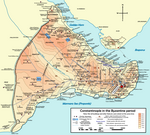Tomb of Abdul Hamid I
1790 establishments in the Ottoman EmpireBuildings and structures completed in 1790FatihOttoman architecture in TurkeyReligious buildings and structures in Istanbul ... and 1 more
Tombs of sultans of the Ottoman Empire

The Tomb of Abdul Hamid I (Turkish: I. Abdülhamid Türbesi) is the final resting place of Ottoman Sultan Abdul Hamid I located at Fatih in Istanbul, Turkey.
Excerpt from the Wikipedia article Tomb of Abdul Hamid I (License: CC BY-SA 3.0, Authors, Images).Tomb of Abdul Hamid I
Hamidiye Caddesi, Istanbul
Geographical coordinates (GPS) Address Nearby Places Show on map
Geographical coordinates (GPS)
| Latitude | Longitude |
|---|---|
| N 41.0155 ° | E 28.974130555556 ° |
Address
Sultan 1. Abdülhamit Türbesi
Hamidiye Caddesi
34112 Istanbul
Türkiye
Open on Google Maps









